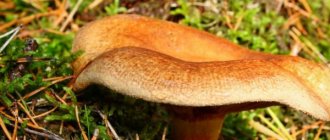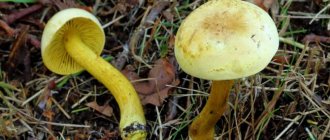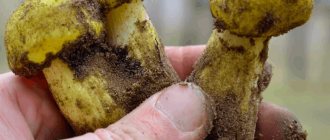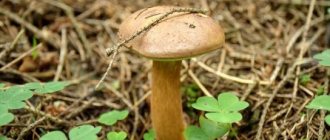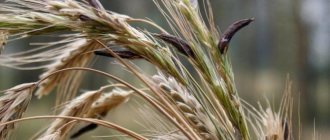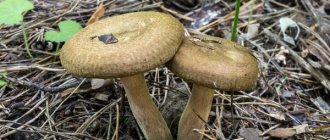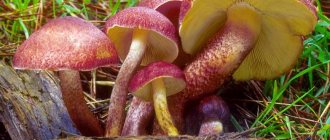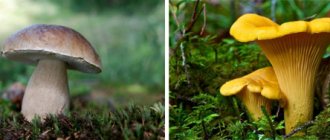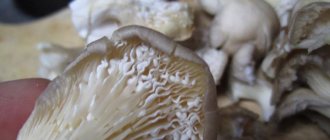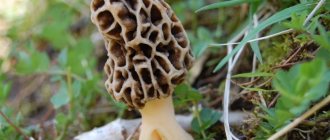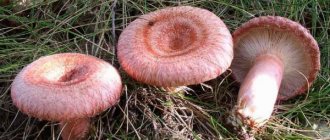Svinushki (svinukhi, dunki) do not belong to the category of ordinary mushrooms, since it is “conditionally edible”, and some species are completely poisonous.
If you prepare it correctly, the danger of poisoning is eliminated, because where it grows, it has been used for a long time, along with other edible mushrooms. Proper pre-cooking allows you to rid the mushroom of harmful substances, after which you can use it for cooking. Most often it is subsequently fried.
Below are accessible, tasty and simple recipes for preparing this mushroom. You will also learn how to properly process, cook or fry pigs and the nuances of cooking in the oven, on the stove, or in a slow cooker.
Features of the view
The mushroom belongs to the Svinushkov family and has several popular names: solokha, dunka, svinukha, black milk mushroom. They got their name from the appearance of dark spots on the surface after touching, which look like dirt on a pig.
The species that is conditionally edible and is eaten is the fat pig. The external data of the mushroom are as follows:
- The cap is concave towards the center and curled at the edges, its diameter is up to 17 cm, the color range is from brown to gray-brown.
- The leg is up to 10 cm high and is similar in color to the cap, of medium density and without additional circles on it. Cylindrical in shape, tapering towards the bottom, diameter up to 1.5 cm.
The habitat of pigs is quite wide - these are coniferous and deciduous forests, shrubs, ravines and swamps of Eastern, Central and Southern Europe, as well as almost the entire territory of Russia, although they are not common. Fat pigs prefer shady areas. The growth period of pigs begins in the spring and continues until frost, which is partly why they are popular.
hat
0
Source:
The mushroom cap can have different sizes, it all depends on the age and place of growth. The largest specimens reach 15 centimeters. Young mushrooms have a convex cap, slightly curved at the edges. The older the mushroom, the lower the central part becomes. Over time, the cap takes on the appearance of a funnel, tightening towards the base. The fruit margins can also be funnel-shaped, but sometimes they are simply drooping, ribbed, or wavy. The color of young mushrooms is usually olive or olive-brown. Over time, they become increasingly gray, acquiring a rusty or grayish-brown color. The surface can be wet, damp, dry, sticky, glossy - it all depends on the weather and conditions of the place where the mushroom grows.
Rules for cooking pig mushrooms
Adherents of eating pigs know how to cook them properly and consider heat treatment a good way to get rid of toxins in the fruiting bodies. Before cooking mushrooms, you should prepare them according to the following scheme:
- Remove debris and dirt, wash thoroughly under running water and soak in water with added salt for at least 5 hours.
Preparing for cooking
- After this time, drain the water and repeat the same procedure twice more.
- After finishing the third soaking, strain the mushrooms through a sieve and only then will they be ready for cooking.
For a housewife who has time and is ready to devote it to preparing pigs for consumption, there is nothing difficult in processing such a mushroom. For every kilogram of fruiting bodies you will need to add a liter of water and a teaspoon of salt.
Total cooking time
In order to cook dunki, you will need a total of 1 hour and 15 minutes of time, but the process must occur in several stages:
- After the pigs are prepared and filled with salted water, you need to bring them to a boil and cook for 5 minutes. It is better to cover them with a lid while boiling.
- Then the brine is drained and the mushrooms are re-filled with a solution of water and salt, brought to a boil and boiled for half an hour a second time.
The process of cooking pigs
Before frying
In order to fry dunki, you should follow the preliminary preparation technology before adding the mushrooms to the frying pan. Required steps:
Fried pigs
You need to fry pigs that are slightly dry after cooking. The process of frying in vegetable oil until cooked takes 10-15 minutes, at the end you can add spices to taste.
For preparation for the winter and before freezing
Pigs can also be prepared for the winter and there are several options for storing them in the winter. There are many recipes for pickling this type of mushroom:
- in vegetable oil;
- in prepared brine;
- with carrots and cinnamon;
- aromatic caviar from pigs;
- cold pickling under pressure.
Pig marinated for the winter with cinnamon in jars
Preliminary heat treatment in the form of cooking is mandatory before any type of workpiece.
You can also put the dunki in the freezer until needed, but before freezing they must be soaked and boiled according to the standard procedure. It is important to note that it is safe to store them frozen for about six months, after which you should not eat the product. To prepare dishes from this type of harvested mushrooms, you must first defrost them and remove the resulting liquid.
Dishes of fried and boiled pigs
Despite the fact that mushrooms require some preliminary manipulation before cooking, they can be used to prepare many delicious and varied dishes. In addition to recipes for preparing pigs for the winter, they are also used in classic recipes with mushrooms, and are also prepared as a separate dish for every day or holiday. Let's look at how to fry mushrooms and some other options for easy-to-prepare recipes with dunki that will appeal to everyone's taste.
Potatoes with pigs
For four servings you need:
- mushrooms – 8 medium-sized pieces;
- potatoes - 8 medium pieces;
- onions – 1 pc.;
- black pepper – 0.5 teaspoon;
- vegetable oil – 75 ml;
- salt - to taste.
Potatoes with pigs
Preparation:
- Cut the pre-peeled mushrooms into medium pieces and boil over low heat for 15-20 minutes. After this, drain the brine and rinse them with cold water. Let drain in a colander.
- Re-cook the pigs over low heat for about 15-20 minutes, pouring clean water. Drain again and wait until the brine has completely drained.
- Pour the mushrooms into a preheated frying pan and fry over low heat until all the moisture is gone.
- Cut the onion into thin rings and add vegetable oil to the already dried mushrooms. Fry for 5-7 minutes.
Potatoes with mushrooms and onions - Peel the potatoes, cut them into half rings of medium thickness, add to the mushrooms.
- Fry over medium heat, cover and stir constantly until the potatoes are cooked.
- Add salt and pepper a couple of minutes before the dish is ready.
Serve hot; you can add vegetables for garnish and spices if desired.
Pigs with sour cream
You will need:
- mushrooms – 200-300 g;
- onions – 1 pc.;
- sour cream – 3 tablespoons;
- garlic – 2 cloves;
- greens - optional;
- vegetable oil – 50 ml;
- salt, pepper - to taste.
Preparation:
- Clean the pigs and divide into large pieces. Boil in salted water for 10 minutes after boiling, then drain and rinse thoroughly, allowing the remaining water to drain.
- Repeat the procedure at least once more, but preferably twice.
- Cut the onion into small pieces and fry until golden brown in a heated frying pan with oil.
- Add mushrooms to the onion and fry over low heat for 20 minutes, add salt and pepper to taste.
- Finely chop the garlic and mix with sour cream, add to the pork and simmer over low heat for about a quarter of an hour.
- Leave the finished dish covered for 10-15 minutes to steep.
- Add greens before serving.
Depending on personal preference, this dish can be served warm or chilled.
Omelette with pigs
Ingredients:
- mushrooms (boiled and chopped) – 1 cup;
- eggs – 4 pcs.;
- onions – 1 pc.;
- butter – 2 tablespoons;
- salt pepper;
- greens - for decoration.
Cooking process:
- Be sure to pre-cook the mushrooms using technology typical for this type. Cut the fruiting bodies into small pieces.
- Finely chop the onion and fry in a frying pan with butter until golden brown.
- Add mushrooms to the pan and fry over medium heat for 5 minutes, add salt and pepper to taste.
- Beat the eggs with a whisk and add salt.
- Pour the eggs into the pan with the mushrooms and onions, cover with a lid and cook over low heat until the omelette is ready.
- Sprinkle with herbs if desired before serving.
This omelette has excellent taste and is quite filling; there is absolutely no need for meat additives.
Important!
The main rule is to boil the fruiting bodies before using them in cooking, which should not be ignored, then nothing will spoil the impressions of tasting pig dishes.
Fried mushrooms in a jar for the winter without sterilization
- Boil 3 kilograms of mushrooms in salted water. Cut 1.5 kg. onions, fry in a small amount of oil, add half a liter of tomato sauce, 1 glass of odorless vegetable oil and mushrooms, simmer for half an hour. Place in a clean jar and screw on the lid.
What a joy it is to go to the cellar in winter and bring back a jar of rolled up fried mushrooms! Pour this wealth into a frying pan and make the whole house close its eyes with pleasure: the indescribable magical smell will seem to take you back to summer, when you just came out of the forest with full baskets.
Fried mushrooms
And in order to give your loved ones such unforgettable moments, you need not to miss that not particularly long and quickly passing period when you can still go to the nearest forest for a mushroom harvest. And before going out, it would be useful to remember the rules of collection, firmly remember what poisonous mushrooms look like, and first aid methods for poisoning (even though your knowledge will never be needed, but you must know how to act in a deadly situation!):
- Mushroom picker's commandments: how not to get lost in the forest and return with a full basket
- Be careful, mushrooms! Golden rules of “quiet hunting”
- 7 Health-Dangerous Myths About Mushrooms
- Two from a casket identical in appearance, or Mushroom twins
- What to do if you are poisoned by mushrooms
Reviews from the network
Source:
To eat or not to eat thin pork is a long discussion that is periodically raised on mushroom forums. Briefly, the theses are as follows: 1. Pork has been eaten for centuries and not bothered. I, too, ate it throughout my childhood, and my parents ate it, and their parents too. It was almost the main mushroom. 2. Someone (who is unknown) at the end of the last century showed that the pig contains certain antigens that cause the formation of antibodies in the body, and derived from this the theory that the pig is poisonous, and fatal. Since then, by decree of the Presidium of the Supreme Soviet of the USSR, the pig was converted into poisonous mushrooms. 3. People who know about this (item 2) basically stopped eating pork, guided by the principle “who knows, maybe it’s true.” Me included. That is why there are so many more pigs in the forests. 4. Many considered the ruling on the toxicity of the pig to be excessively far-fetched and continue to eat it, guided by the fact that before everyone always ate it and had no problems. 5. Whether to eat pork or not is everyone’s personal choice. For example, it’s psychologically safer for me not to eat it. And in general, mushrooms interest me more from a scientific point of view than from a gastronomic one, so I don’t suffer from this omission at all.
Should you boil mushrooms before frying or not?
A novice housewife will definitely face this question. And many decide that it is better to play it safe than to worry about the safety of their products. To feel confident, of course, it is better to know for sure which mushrooms need additional heat treatment and which do not. Let's take a closer look at the rules.
Does not require pre-boiling
Edible and conditionally edible mushrooms are prepared differently. Edible mushrooms can be fried immediately. These include:
- white;
- boletus;
- flywheels;
- boletus;
- boletus;
- chanterelles;
- saffron milk caps;
- umbrellas;
- Champignon;
- hedgehogs;
- rows;
- oyster mushrooms;
- Russula;
- honey mushrooms
Fried mushrooms
Naturally, additional heat treatment of edible mushrooms will not harm the human body. But their nutritional value decreases, the specific mushroom aroma weakens and the taste deteriorates. And some mushrooms become slippery even after boiling for a short time.
Must be boiled
But conditionally edible mushrooms must be boiled before frying. This helps reduce toxicity to a safe level and eliminate the acrid taste: the toxic substances of such a mushroom dissolve in water when heated, we pour it out, and the mushrooms themselves become edible. Be sure to boil:
- ordinary lines;
- pink waves;
- brittle and stinging russula;
- milk mushrooms are black and yellow.
Because of the bitter taste, all those mushrooms that have a burning milky juice are soaked and boiled:
- camphor, alder and sweetish laticifers;
- bitters;
- violins;
- earrings;
- white loading pads;
- some types of russula, pigs and talkers;
- moths;
- some other mushrooms.
When cooked, the bitterness transfers to the water, and the taste of the mushrooms improves significantly. Many summer residents explain the need for preliminary boiling by the fact that this will additionally clean the mushrooms from environmental pollution.
Some mushrooms need to be boiled first
Be that as it may, you need to rely both on theoretical data about the group affiliation of mushrooms, and on local conditions and traditions. It’s good if knowledge about mushrooms is passed on from generation to generation. In such families, “mushroom” troubles almost never happen.
Should I eat mycelium from dunki?
No. Who told you that dunka is an edible mushroom? Dunka mushrooms are poisonous inedible mushrooms. Although until recently they were considered semi-poisonous. Literally 5 years ago, Wikipedia claimed that they can be eaten. But that's not true.
Many people are now looking on the Internet for articles on how to cook dunka mushrooms or how to pickle dunka mushrooms. But this makes no sense, since mushrooms are strictly prohibited for consumption.
On a note! If you eat dunka, you may die. That's how poisonous they are. Dunki contain toxins that do not disappear even after intensive heat treatment. Do not under any circumstances eat these mushrooms.
Fried mushrooms with pre-boiling
Since many housewives still boil all mushrooms without exception before frying, we will pay special attention to this method. Let's look at the process step by step.
Step One: Cleaning
Mushrooms brought from the forest should be soaked in cold salt water for 1.5-2 hours, then rinsed and peeled.
Tip: the stems of boletus and honey mushrooms turn out to be harsh when fried, so it is better to cut them off and dry them - in winter, when ground, they are perfect for preparing mushroom sauces and soups.
Cleaning mushrooms
Step two: first boiling
Pour cold water over the mushrooms, bring to a boil and simmer over low heat for 15 minutes, skimming off the foam that formed during boiling. After a quarter of an hour, drain the mushrooms in a colander and rinse with water.
Tip: when cooking porcini mushrooms, you can add a small amount of citric acid to the water (about 3 g per 1 liter of water) to prevent them from darkening.
Boiling mushrooms
Step three: second boiling
Pour clean water over the mushrooms again, bring to a boil and simmer again over low heat for 10-15 minutes. After cooking, drain the water and rinse the mushrooms again.
After cooking, mushrooms must be washed
Step four: frying mushrooms
When the water drains from the mushrooms after washing, they need to be cut into pieces of the intended size, then put in a dry frying pan (without adding oil!) and kept over low heat, stirring until the liquid evaporates. Then it’s time to add vegetable oil, animal fat or butter (preferably ghee). Fry the mushrooms in oil for 25-30 minutes, remembering to stir. A few minutes before the end of frying, add salt to taste.
Frying mushrooms
Step five: placing fried mushrooms in jars
Transfer the mushrooms directly from the frying pan into dry, hot, sterilized jars. In each of them there should be 1-1.5 cm of free space above the mushrooms for oil (fat). It is best to fill it with the oil in which the mushrooms were fried, but if this oil is not enough, you need to add new oil to the pan, heat it and add it to the jars while boiling.
Advice: if you prefer animal fat for preparations, its layer on top of the jar will need to be salted directly while it is hot.
Step six: sterilization
Roll up the filled jars and sterilize (completely submerged in salt water) for 60 minutes. Then turn over onto the lids, wrap thoroughly and leave to cool for 2 days.
Tip: if the mushrooms are stored in the refrigerator, they do not need to be sterilized and stored under nylon covers.
Other name
The most common name is svinushka, but you can also hear variations like pig or svinukha. In some territories they are known as solopens or solokhs. Another name that is common among the population is duni, dunki or cowsheds. One way or another, the Latin name of the mushroom Paxillus involutus is translated as thin pig.
Did you know?
Mushrooms have their own kingdom.
For a long time, scientists could not determine whether mushrooms belonged to plants or animals. The fact is that in terms of the composition of proteins they are closer to animals, but in terms of the amount of carbohydrates and other minerals are
like plants, which is why they were separated into their own separate kingdom.
Fried mushrooms without boiling
Experienced mushroom pickers, knowing well the properties of the mushrooms that “caught” in their baskets, believe that boiling definitely edible mushrooms - porcini, chanterelles, champignons, moss mushrooms or boletus - only spoils their taste. Therefore, they immediately throw them into the frying pan.
White mushrooms, chanterelles, champignons, mushrooms or butter mushrooms do not need to be boiled
Let us now look at this, in essence, quite short-term procurement process:
- Peel, rinse and drain the mushrooms brought from the forest in a colander to drain;
- cut all the mushrooms into slices;
- Pour vegetable oil (or a mixture of fats) into a deep frying pan, heat well and add mushrooms to the hot oil;
- With the lid closed, fry them over low heat for about an hour, keeping an eye on them and stirring. During this time they will stew in their own juice;
- then remove the lid and keep the frying pan on the fire until all the mushroom juice has evaporated and the oil becomes clear;
- place the mushrooms directly from the frying pan into dry hot jars , leaving 10-12 mm on top for oil;
- top up with boiling oil from the frying pan;
Where and when to collect dunki
You can go out in search of pigs from the end of spring and collect them before the temperature drops. Since this species loves damp and shady places, colonies of fungi are found under trees (oak, birch, coniferous varieties), shrubs, on mosses, in forests, and sometimes on trunks. Dunki are rarely found alone, so even from one clearing you can leave with a full basket of harvest.
Also read: Types of mushrooms and mushroom places in Bashkiria
Experienced mushroom pickers advise cutting off young specimens, since at this time they have elasticity. A distinctive feature of young mushrooms is their small size and slightly shaggy cap. The inside of old dunikas is loose.
The negative properties of dunekas include significant absorption of chemicals, radioisotopes and heavy metals from neighboring fields and nearby roads. Due to this feature, it is prohibited to collect dunki growing near industrial enterprises and highways.
Experienced mushroom pickers advise cutting off young specimens, since at this time they have elasticity.
Delicious recipes
Of course, who can resist sitting down to the table right away and, without waiting for winter or a holiday, happily “crush” some of the fried mushrooms with fresh herbs and fragrant black bread!
Fried chanterelles
To prepare you will need:
- fresh chanterelles – 1 kg;
- vegetable oil – 0.5-0.8 cups;
- bay leaf – 3-4 pcs.;
- salt - to taste.
Cooking recipe: 1. Wash and chop the chanterelles, if that’s what you plan to do. For frying, you can take either separate vegetable oil, butter, lard, or a mixture of fats - as you like. Fry the chanterelles over low heat for 40 minutes. under the lid. 2. Remove the lid, salt the mushrooms, add bay leaf (you can add onion, black pepper or cloves for taste) and fry over low heat until the juice has completely evaporated and the chanterelles have acquired a beautiful golden color. 3. Transfer them into prepared heated jars and add oil from the frying pan to the top so that the layer of oil above the mushrooms is 1-1.5 cm.
Fried chanterelles
4. Sterilize the jars in salt water for 35-50 minutes, roll them up, turn them over onto the lids and wrap them well until they cool. After two days, transfer the jars to a cool, dark place.
Bulgarian fried mushrooms
To prepare you will need:
- mushrooms – 1 kg;
- vegetable oil – 0.5-0.8 cups;
- table vinegar 9% – 3-4 tbsp. spoons;
- 3-4 cloves of garlic;
- 2-3 tbsp. spoons of chopped greens;
- salt - to taste.
Cooking recipe: 1. This is how definitely edible mushrooms are prepared. All of them need to be cleaned, washed thoroughly, chopped and quickly fried in oil over medium-high heat (do not simmer with a lid!).
Bulgarian fried mushrooms
2. Transfer the mushrooms into dry, heated jars, adding cloves of peeled garlic and finely chopped herbs. 3. Add salt and vinegar to the oil remaining after frying and bring to a boil. Pour this oil over the mushrooms so that the layer above the mushrooms is at least 3 cm. Sterilize in salt water for 45-50 minutes. These mushrooms are stored in the refrigerator.
How to properly fry pigs
There are many different recipes for frying them. One of the easiest ways is to cook pig mushrooms in sour cream. It turns out very tasty. Mushrooms and sour cream are always a good combination of products.
- pigs - 1 kg;
- sour cream - 4 tbsp. spoons;
- one onion;
- sunflower oil;
- two cloves of garlic;
- salt to taste.
Step-by-step recommendations on how to fry pork mushrooms:
1. First, sauté the onion in oil until golden brown.
2. Next, ready-boiled pork and salt are added, and all this is fried over low heat.
3. Then you need to add garlic and sour cream and simmer for 8 minutes.
The dish should be allowed to brew and soak. And after 20 minutes it can be eaten.
Storing fried mushrooms
Fried mushrooms are stored in refrigerators, basements or cellars. Under plastic lids they remain suitable for 4-6 months, and rolled up with metal lids they can be stored longer.
Since long-term storage of mushrooms under lids may pose a threat of botulism infection, it is vitally important to take all measures to eliminate this possibility. You can read in detail how to do this in the article Pickling mushrooms for the winter.
Fried mushrooms can also be stored in the freezer. To do this, fried, cooled mushrooms are packaged in plastic containers or plastic bags, excess air is squeezed out of the bags and placed in the freezer. When frozen, such mushrooms will be stored longer, and there will be no risk of contracting botulism.
Fried mushrooms can be stored in the freezer
Why can I die if I eat dunka mushroom?
Because these mushrooms contain lectin. And this is a very dangerous toxin that is contained in dunka mushrooms. The action of the lectin is aimed at red blood cells, which are responsible for the supply of oxygen to the cells. This toxin causes red blood cells to decompose. Once red blood cells begin to decompose, the supply of oxygen to the cells is reduced.
Because of this, hemolytic anemia occurs. Then nephropathy begins, then jaundice, then renal failure. And this is only if the dose is not very large. If you have urolithiasis or, for example, a tendency to some kind of allergy, even small doses of this toxin are strictly prohibited.
But that's not all. Dunki contain an extremely dangerous alkaloid of a specific type. This is muscarine. This alkaloid is also found in red and white fly agarics. If you eat large amounts of muscarine, you will experience vomiting and other signs of poisoning (such as diarrhea and abdominal pain), a decrease in heart rate (pulse will slow down), problems with vision (it will simply worsen sharply), and breathing problems are observed (pulmonary edema is possible). Among other things, this alkaloid has a significant effect on the brain and leads to drug addiction.
On a note! Some citizens practice drinking alcohol with poisonous mushrooms, for example, dunki, which contain the alkaloid muscarine, in order to cause hallucinations. Do not do this under any circumstances. In addition to the fact that you will experience one of the most unpleasant conditions, as well as a sharp deterioration in your health and general condition of the body, you can also die.
Among other things, if you eat dunka mushrooms, you will not immediately realize that you have been poisoned. As is the case with other poisonous mushrooms, for example, with toadstool. Because in Dunka the effect of the toxin is not so pronounced. You will realize that you are poisoned after about a week (well, it depends on how much you ate, and also on the age of the mushrooms).
If you still want to try dunka, we have another surprise for you. Dunka mushrooms accumulate radioactive isotopes, which have a destructive effect on all internal organs and cells, cause cancer and lead to death.
Dunki are very dangerous mushrooms. We strongly do not recommend eating them. When picking mushrooms, be careful and always examine the mushroom for toxicity before putting it in the basket.
Useful tips from summer residents
- when frying mushrooms for the winter, there should be enough fat in the pan for the mushrooms to float in it;
- no matter what mushrooms are fried, they need to be salted at the very end of cooking;
- If the mushrooms were in water (boiled, soaked or simply washed), they must be dried before frying. To do this, you can use napkins, fabric or paper towels;
- If you have collected a lot of mushrooms of several types, it is better to sort them by variety and fry each type separately. This way the taste will be more specific and the appearance more attractive;
- It is better to clean boletus before washing, while the cap is dry and not slippery;
- Mushrooms drenched in melted butter may begin to taste bitter over time, but this does not happen with lard;
- You can use a slow cooker to fry mushrooms.
You can also find many interesting mushroom recipes in other materials on the site:
- Quickly marinated mushrooms in Venezuelan style
- Take out the jars and barrels - salt the mushrooms for the winter
- Mushroom crust
- I'm preparing honey mushrooms
- Honey mushrooms in tomato sauce for the winter
- Winter salad of peppers and wild mushrooms
- Vegetable salad with chanterelles for the winter
- Collecting and pickling autumn mushrooms
- Saffron milk caps, volushki, milk mushrooms. Salt and eat
Fried mushrooms are a real delicacy that, without exaggeration, is loved in every Russian family. Therefore, we hope that our tips will help you diversify your winter table even more with preparations such as mushrooms canned in oil and fat. We will be very glad if you share your recipes and successful “mushroom” finds.
Mushroom dishes are loved in every family
And there is also a good folk sign: the mushrooms have run out if the anthill is already closed for the winter. But the ants are still “working”, so you and I still have time for winter preparations!
- Author: Maria Sukhorukikh
Rate this article:
- 5
- 4
- 3
- 2
- 1
(0 votes, average: 0 out of 5)
Share with your friends!
Signs of poisoning and first aid
The problem is that it is very difficult to determine poisoning. But there are still some signs that not everything is in order with the body and, perhaps, the mushroom was poisonous:
- in small quantities and with prolonged use, the toxin causes a reaction resembling an intestinal infection. At the same time, the body can very rarely cope with it and suppress the effect of the poison, so the condition lasts for quite a long time;
- malaise for a long period;
- if a lot of mushrooms have been eaten, the reaction occurs within 2-4 hours and is highly intense;
- vomiting, diarrhea, increased peristalsis are the most obvious signs of poisoning;
- the appearance of bruises and bleeding, pallor;
- blood tests reveal a change in the number of red blood cells, an increase in bilirubin is observed;
- jaundice begins to develop;
- the pupils narrow, vision is impaired;
- a person may experience shortness of breath, lacking air;
- heart rhythm is disrupted.
Sometimes, if the poisoning was minimal, decreased immunity, drowsiness, malaise, vomiting and diarrhea continue for a long time, but go away on their own. Sometimes a person may not even know what caused this condition.
In particularly difficult cases, diagnostics in a hospital cannot be avoided. It is necessary to take blood tests. In cases of jaundice or renal failure, hospitalization is required.
Did you know?
Mushrooms existed on our planet more than 400 million years ago, which has been scientifically proven. Therefore, mushrooms are even older than dinosaurs and the oldest inhabitants of the Earth, along with ferns.
Video: first aid for mushroom poisoning
First aid, which must be provided to a person if there are signs of mushroom poisoning, is as follows:
- Induce vomiting. This will help clear your stomach of large pieces of mushrooms. This can be done with salt diluted in water or mustard powder. You need to drink a lot of water, this also causes vomiting.
- Important: if you are unconscious, it is forbidden to induce vomiting, as the vomit may enter the lungs.
- Gastric lavage.
- Drink activated carbon.
- In severe cases, you must call an ambulance.
- If you are poisoned by pigs, going to the hospital is mandatory.
Pig mushrooms are quite dangerous mushrooms that can have a very detrimental effect on the body.
And although they can be cooked, it is not recommended to eat them, since recent studies have shown that the toxin contained in it is not destroyed. You need to be very careful when picking mushrooms in summer and autumn.
Many housewives want to learn how to pickle mushrooms and store them correctly. The appetizer is perfect for any table and can be used as a side dish. The aromatic preparation is also used for preparing salads. You can preserve both store-bought mushrooms (oyster mushrooms, champignons) and home-harvested mushrooms. The most popular among mushroom pickers are dunki (pig mushrooms), honey mushrooms and porcini mushrooms. They are rolled with carrots, vinegar, oil, and seasoned with bay leaf and garlic. Preservation should be stored in jars; without sterilization, pickled mushrooms can last for 3-4 months. The following photo and video recipes will tell you in detail how to pickle mushrooms at home for the winter.
How to cook pork
You will need: pigs, water for soaking, water for cooking in 2 stages, salt
1. Before cooking the pig, clean it from forest debris, wash it and soak it in salted water for 5 hours, drain the water. 2. Repeat the soaking process two more times. 3. Strain the soaked pigs through a sieve, put in a saucepan and add water. 4. For 1 kilogram of mushrooms for boiling, add 1 liter of water and 1 teaspoon of salt. 5. Bring the svinushki to a boil, after boiling the svinushki, reduce the burner power to medium and cook for 5 minutes, covering with a lid. 6. Drain the hot water. 7. Pour cold water over the pigs again, boil and cook for 30 minutes; drain the broth. 8. Pour fresh cold water over the svinushki one last time, bring to a boil and cook for 40 minutes until fully cooked. 9. Place the boiled pigs on a sieve, cool, transfer to a bowl and use as intended. Wound the mushrooms in the broth in the refrigerator for no more than 3 days.
How to salt pigs
Products for salting pigs
for 1 kilogram of fresh pigs
Coarse salt - 50 grams Dill - 10 sprigs Black currant leaves - 3 leaves Peppercorns - 5 pieces Garlic - 5 cloves
How to salt pork
1. Peel, wash, soak and cook the pigs. 2. After cooking, place the pork in a colander and cool. 3. Place the pigs into a sterilized jar, sprinkle with salt and add garlic and pepper. Then add boiled water and cool. 4. Place the mushrooms in a container under pressure for 3 hours, then add the boiled mushrooms again, sprinkling with salt and seasonings. The pork brine should completely cover the mushrooms. 5. Store pigs at a temperature of 5-8 degrees, in a dry, dark place. 6. The pigs are salted for 45 days.
How to marinate pigs
How to marinate pigs
for 1 liter of marinade for pigs
Coarse salt - 2 tablespoons Vinegar 9% - half a glass Black peppercorns - 5 pieces Bay leaves - a couple of leaves Dill - 5 stems Cinnamon - on the tip of a knife Sugar - 2 tablespoons Garlic - 10 cloves
How to marinate pigs
1. Boil pork. 2. Prepare the marinade: put salt and spices in water, add vinegar, put on fire. 3. When the marinade boils, add mushrooms. 3. Cook for 20 minutes, skimming off the foam. 4. Remove the pan with the pigs from the heat. 5. Cool the pigs. 6. Place the mushrooms in a jar, pour in the remaining marinade. 7. Pour 2 tablespoons of vegetable oil on top.
Salad with boiled pigs
Products
Boiled pigs - 150 grams Onions - 3 small onions Vegetable oil - 3 teaspoons Vinegar 3% - 0.5 teaspoons Parsley - a couple of sprigs for decoration
Making a salad with pigs
1. Cut the pigs into thin slices, leaving small ones for decoration. 2. Chop the onion. 3. Finely chop the greens. 4. Mix onions with pigs. 5. Season the salad with oil. 5. Sprinkle with vinegar. 6. Sprinkle the salad with herbs and garnish with whole small mushrooms.
